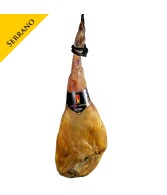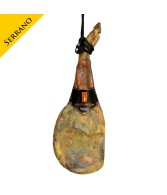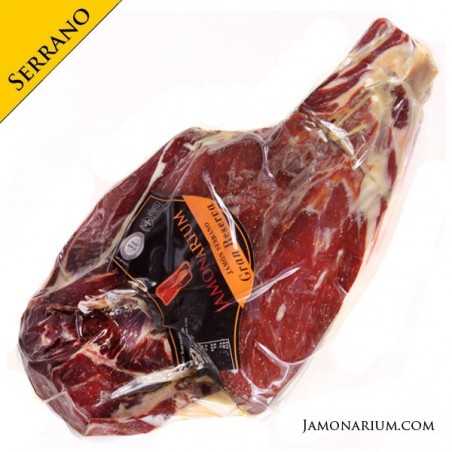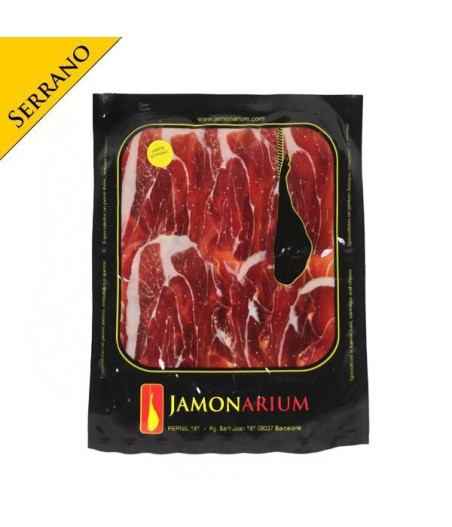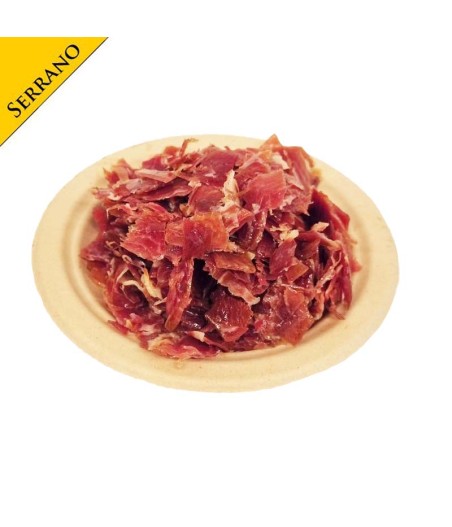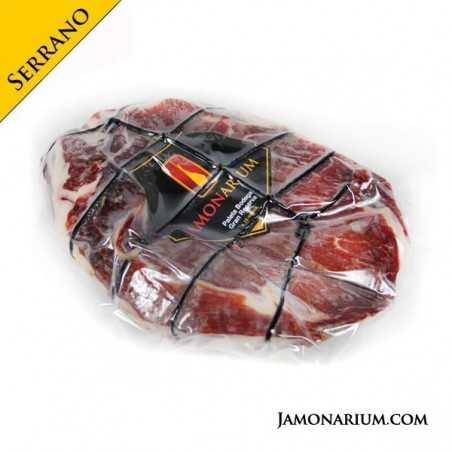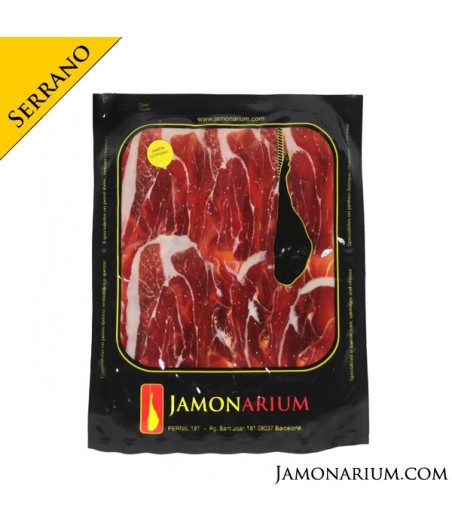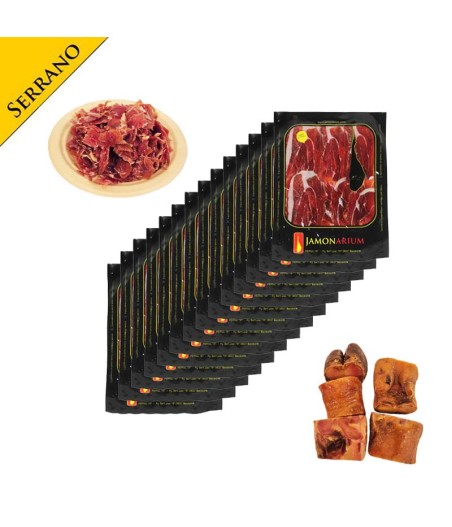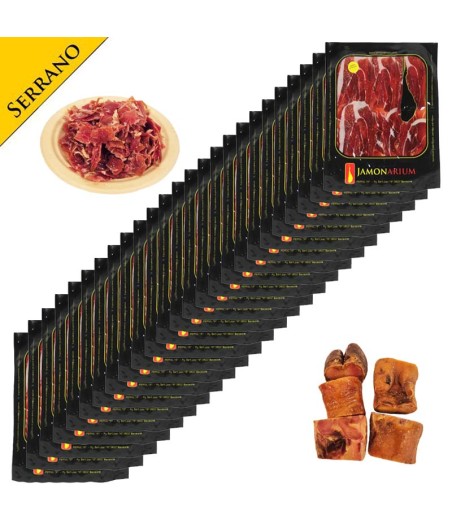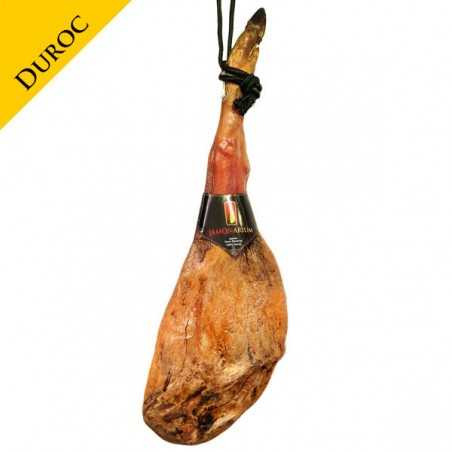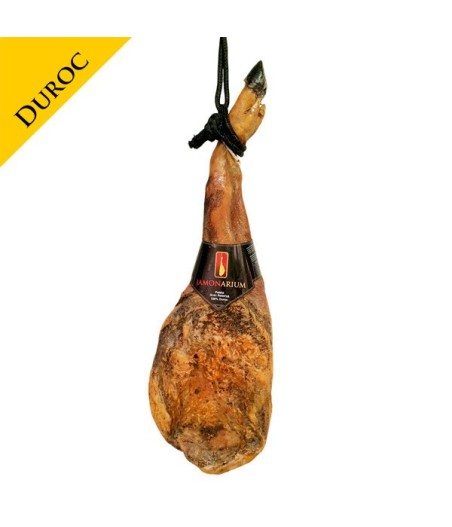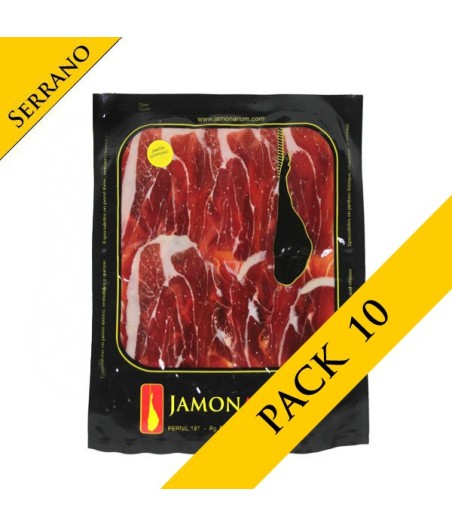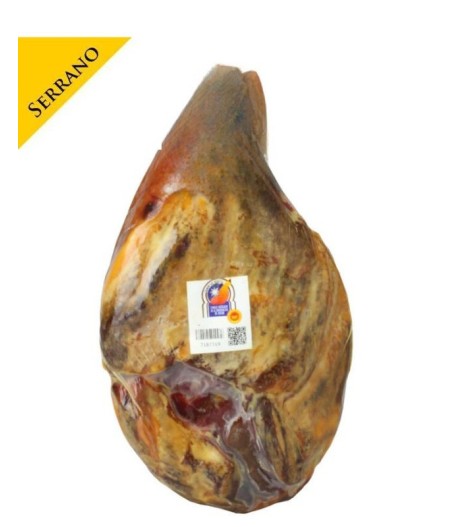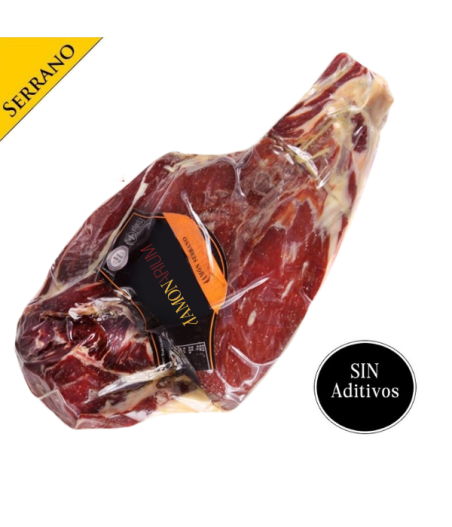Serrano ham
- What is Serrano ham?
- The history of Serrano ham
- Which are the characteristics of Serrano ham?
- Which are the differences among different types of hams?
- Curing, a key element in the quality of cured and serrano ham
- Which is the manufacturing process of Serrano hams?
- Which are the production areas of serrano hams?
- Which are the serrano hams in the world?
- How to choose a good Serrano ham?
- Which are the curiosities of Serrano ham?
- Recipes with serrano or cured ham
Our serrano hams and shoulders
1. What is Serrano ham?
Serrano ham comes from white pigs. Serrano hams and shoulders are obtained from the hind and front legs of the white pig, respectively. The pieces undergo a salting and air drying process for a specific period, which ranges from 12 to 20 months. Serrano hams and shoulders are very popular foods in Spanish gastronomy.
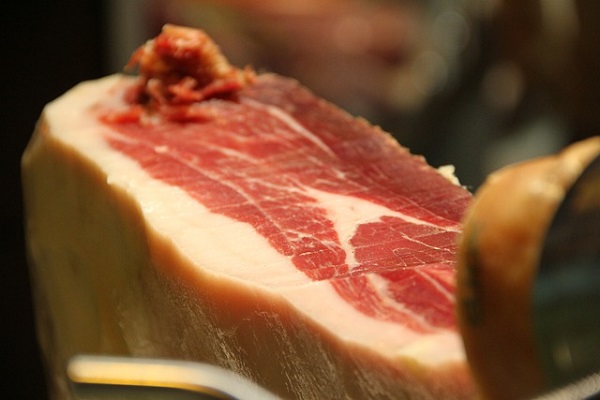
2. The history of Serrano ham
Serrano ham was established in the Iberian Peninsula thanks to the Phoenicians around 1100 B.C. Its first settlement took place in the city of Gádir, currently known as Cádiz. At the time of the Roman Empire, the pig was considered a basic product and even considered as an object of worship. At that time, all parts of the pig were used to make different meat products.
Serrano and cured hams were considered luxury products and were reserved for those belonging to the high social classes. This product became as important to the market of these civilizations that even ham-shaped coins were created.
During the Medieval and the Modern Age, pork continued to be a very common product for consumption in different formats. Finally, from the end of the XIX century and beginning of the XX century, when Serrano ham became very popular among the population thanks to the development of meat preparation techniques.
The name that this ham receives has its origin, referring to the environment in which the hams are cured, usually in the mountains. The hams are cured here thanks to their climate and environment.
Our serrano hams
3. Which are the characteristics of Serrano ham?
Serrano ham is characterized by coming from white pigs. Their diet is based on natural feeds and they are raised on farms under an intensive regime. There are different breeds of white pigs such as Duroc, Landrace, Large White and Pietrain, among others. The Duroc ham breed is the most used to make the pieces of Serrano hams and shoulders. It is one of the most popular among white pig breeds and comes from the United States.
The meat of the Serrano ham is lean and its hoof is of a light color. The color of the meat may vary from pink to purple red and it has a delicate and slightly salty flavor and a fibrous texture. The piece is elongated and rounded at its edges. The fat is bright white or yellowish in color and has a pleasant taste and aroma.
The skin of the ham or shoulder is presented in a round cut (keeping the crust), which is the most common in this type of hams, although they may also have the typical V-cut. The weight of Serrano hams usually vary between 6 and 9 kilos and shoulders may vary from 4 to 6.5 kilos.
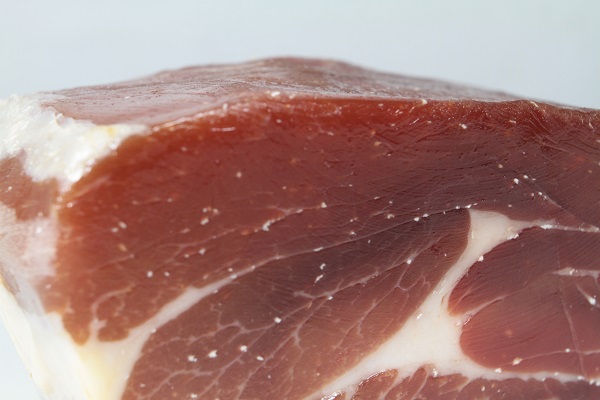
4. Which are the differences among different types of hams?
What are the differences between Serrano and Iberico hams?
The main difference between a Serrano and a Iberico ham is the breed of pig. While Serrano hams comes from white pigs, Iberian hams comes from Iberian pigs. The Iberian pig is a breed native from the Iberian peninsula, which has very different physical, food and living conditions in comparison to the white pig. The ham obtained from both pigs is very different in appearance and flavor. Their main differences are the following:
-
Breeding: White pigs are raised on an intensive basis, in farms and fed with authorized feeds. We have to keep in mind that they come from different breeds of pig, so the result will be simply different. On the other hand, the breeding of Iberian pigs will differ according to its diet during their fattening.
-
Fat: The fat of the serrano ham is white turning yellowish, while the fat of the Iberian ham is transparent. The flavor is also different. While the fat of the Iberico ham has a smooth and fruity flavor, the fat of the Serrano ham has a soft flavor.
-
Curing time: The Iberian pig has infiltrated fat into the muscle, so it will take longer to cure than serrano hams. The curing period for Gran Reserva and Gran Reserva Selección hams and shoulders may vary between 15 to 20 months.
-
Meat: The color in the meat of Serrano ham is matt pinkish, while in Iberian ham the meat is much more reddish and shiny.
-
Hoof: The hoof of an Iberian ham is black or blackish, while that of the Serrano ham is much lighter, turning to brown.
-
Taste: Given the feeding of the pigs during its fattening season, the flavor will also be different. The flavor of Serrano hams is softer and less intense, while that of Iberian ham tends to be more fruity.
Iberian hams and serrano hams are different products since they come from different breeds of pig. It is more important for the hams to have a long curing period than the pig breed. There exists cured and Serrano hams of excellent quality in the market, that are a pleasure to taste, especially the Gran Reserva and Gran Reserva Selección hams. About tastes there is nothing written!
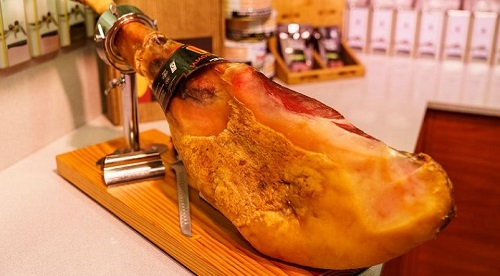
What differences between serrano ham and cured ham?
Serrano and cured hams are two products obtained from white pigs. Both products have been subjected to the salting period, although the main difference between them is the curing time. This period in cured hams will be around 7 months, while those Gran Reserva and Gran Reserva Selección will be between 15 and 20 months.
For a piece to be of good quality, the main thing is that the curing period has been correctly done and as long as possible. Actually, the difference between them is the certification that both products have obtained.
5. Curing, a key element in the quality of cured and serrano ham
Curing is the most important element when evaluating and categorizing the quality of cured and serrano hams. According to its curing time, we have different categories of Serrano or cured hams:
- Cellar: less than 12 months
- Reserva: curing between 12 to 15 months.
- Gran Reserva: curing longer than 15 months.
Serrano Gran Reserva or Gran Reserva Selección hams and shoulders are those having a longer production period, so that, they are considered of the highest quality. While the curing period of shoulders is minimum 15 months, the curing period of hams is minimum 20 months.
6. Which is the manufacturing process of Serrano hams?
The production of Serrano ham is very similar to that of Iberico ham. The main difference between them is the curying period.
During the manufacturing process of serrano and cured hams, the salting phase lasts fourteen days, in which the pieces are placed next to each other, forming rows and covered with salt. Afterwards, the piece starts the post-salting phase in which it is intended to equalize the salt concentration of each ham. It normally lasts between 45 and 90 days. Before starting the curing phase, the piece is washed with warm water to remove all the salt left.
During the curing period, Serrano ham develops all its aroma and flavor. It is considered the most important step in the production of serrano and cured hams, since it is gives its quality.
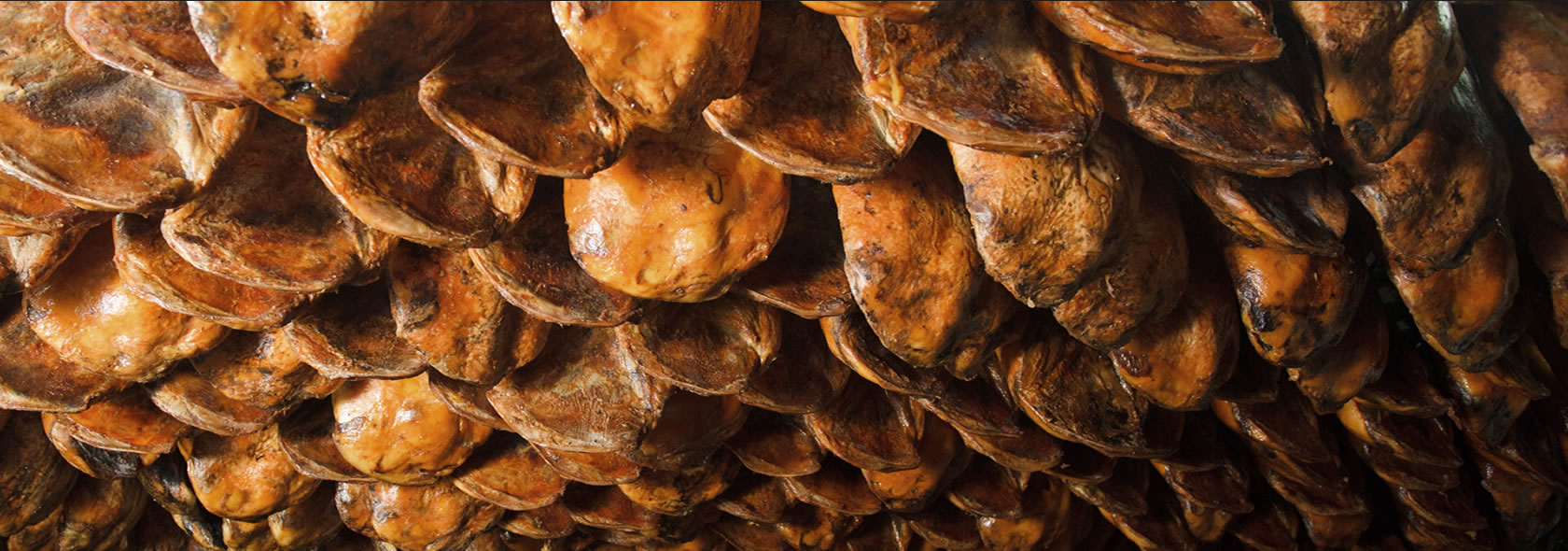
7. Which are the production areas of serrano hams?
Another way to classify Serrano hams is the region where the pig have been raised. In Spain we have a Designation of Origin and two PGIs of Serrano ham. The difference between both types of certifications is that those hams with PGI certification may have been raised in other areas. The certifications of cured and serrano hams in Spain are the following:
- D.O. Jamón de Teruel: Pigs under this name are raised exclusively in the province of Teruel. They are identified by an eight-pointed star carved into their rind and the label certifying its origin. The minimum weight of the hams is 7 kg, while that of the shoulders is 4.5 kg. Regarding the elaboration period, that of the shoulders is a minimum of 36 weeks while that of the hams is 60 weeks.
- PGI Jamón de Trevélez: These hams are made in the province of Granada, in the towns around Sierra Nevada. The hams protected under this PGI may be obtained from Duroc, Landrace and Large White pigs. Its cure usually ranges from 14 and 30 months depending on whether it is ham or shoulder.
- PGI Serón: These hams are made in Serón, Almería. The hams under this PGI are obtained from pigs of the Duroc, Large White, Landrace, Belgian White, Pietrain and Chato Murciano breeds. The minimum weight of the pieces usually varies between 7 and 8 kilos and the curing time varies between 7 and 8 months, depending on the category of the ham.
In addition to the Designations of Origin and the existing PGI, most of the pieces of Serrano hams are produced in other areas, such as in Catalonia or Castilla y León, among others.

Our serrano hams
8. Which are the serrano hams in the world?
Although the serrano ham is something very characteristic of Spain, we can also find several countries in the world where it is also popular. This type of product is very characteristic of southwestern Europe, but we can also find it in countries on other continents, such as the case of Argentina. They distinguish Serrano hams from raw hams by covering them with paprika. The countries in where we can find Serrano and / or cured hams are the following:
-
Portugal: Being part of the Iberian peninsula, we can find Iberian hams, cured and serrano hams, very similar to those made in Spain. As ham or serrano and cured "presunto", we find the Chaves and Lamego hams. These hams are produced in the northern and northeastern areas of Portugal and both are coming from white pigs. Its curing varies between 18 and 24 months. There are also two Iberian hams: Alentejo or DOP Barrancos.
-
Italy: Italian hams are very similar to Spanish serrano hams, although they are not identical in any case. While the prosciutto is sweeter, Serrano hams have a more intense and cured flavor. The most famous types of Italian prosciutto are the "Prosciutto di Parma", the "Prosciutto di San Daniele" and the "Speck Alto Adige". All these types of hams are made in northern Italy. The curing period of Parma and San Daniele hams is around one year, while that of "Speck Alto Adige" is around 22 weeks.
-
France: French hams are also quite famous and similar to Serrano hams, but they have shorter curing periods. The most popular French hams are the following: Bayonne ham, Jambon sec, Jambon sec supérieur and Jambon cru. The Bayonne ham is the only one that has the distinctive PGI (Protected Geographical Indication) of the European Union. Although these hams are the most important, there are many more types.
-
Germany: The most famous German hams are: Ammerland ham, Black Forest ham and Westphalie ham. The first two named hams have the European Union's IGP certification, which have been deboned and subjected to the salting and curing process.
-
Belgium: This country simply has a type of ham that may be similar to the Serrano ham: the Ardennes ham. For its elaboration, it has been cold smoked for several weeks until its drying phase.
- Hungary: The ham from Hungary comes from Mangalica pigs. The most characteristic thing about mangalica pigs is they have very thick hair, even looks like wool. This pig breed is native to the country and has common origins with Iberian pigs. The preparation of hams from these pigs is very similar to that of Iberian hams.
Serrano hams in America
- United States: Hams from the United States are called Country Ham and are especially famous in the area of Virginia. The production method consists of salting the ham for a month and the drying process is 4 months. Finally, the ham is smoked.
- Argentina: Hams from Argentina have the particularity that they are covered using paprika to distinguish them from raw ham.
Serrano hams in Asia
- China: The type of ham most similar to the Serrano from China is the Jinhua ham. Its appearance is similar to that of Serrano ham, although its production period is between 8 and 10 months.
9. How to choose a good Serrano ham?
There are different external factors that may help us in our decision:
- The leg area has to be rounded, without clefts, and rich in muscle and fat.
- The piece must be homogeneous in both in color and surface. If there is a cleft, it will indicate that it may be overdryed, excessively cured.
- The fat color should be yellowish white. If the fat color is intense yellow, brown or orange, then the fat of the piece is rarefied.
- It is preferred to have a fat covering as that adds flavor to the meat, without warn areas. To check it, we must note that the side of the ham (the widest part of the piece), is all covered in fat. It continues towards the tip or hip where the thickness of the fat will be around one and a half centimeters.
- Make sure that your piece has a long curying period, as this will provide with more quality.
- When buying a serrano ham, check that it has the yellow label and its corresponding band.
.jpg)
10. Which are the curiosities of Serrano ham?
These are some of the most curious facts about the preservation and consumption of Serrano hams. Although this product has a very widespread consumption, here we leave you some useful data.
-
It is recommended to be consumed at room temperature. Although its preservation will vary according to the format, at room temperature its olfactory and gustatory characteristics may be appreciated.
-
There is no difference in quality and flavor between the left and right legs ,just as there is no difference between hams from the males and females.
-
When our ham has white crystals, it is not bad. This is amino acid tyrosine concentrations and means that the ham has been properly cured.
-
In case of acquiring a whole piece, it is recommended to consume it as slicing it to enjoy its texture and aroma as much as possible.
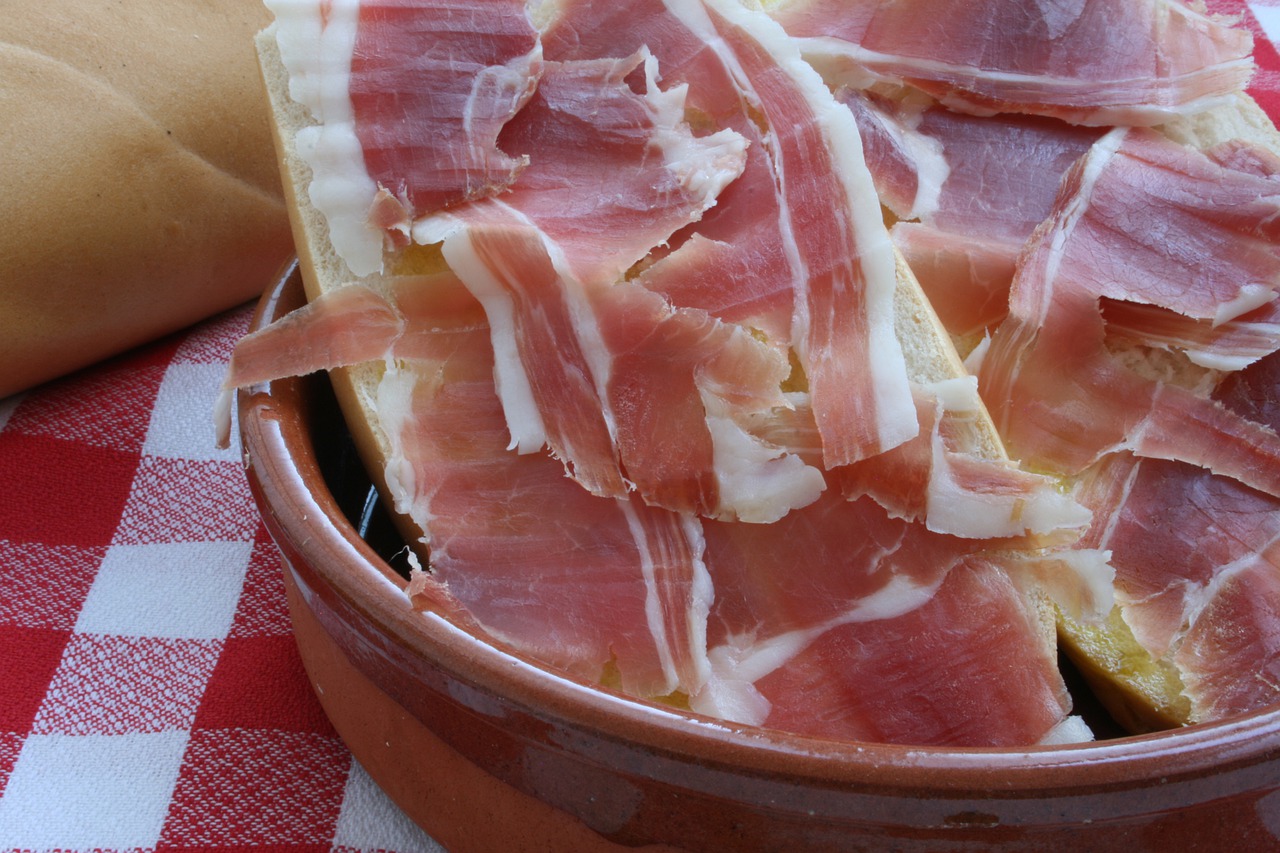
11. Recipes with serrano or cured ham
French style peas
Ingredients:
1 garlic clove
Serrano ham. It can be diced or cut into small pieces.
1 egg
Green peas
Elaboration
First, we chop the garlic and brown it in the pan.
Once we have this, we boil the egg during 15 minutes.
We put the peas in the pan once the garlic has been browned and sauté everything together.
Once the peas have been made with the garlic, we lower the heat and add the strips of ham. Put all together and integrate it.
Once we have the egg boiled, we chop it and integrate it with the garlic, the peas and the ham.
Asparagus with serrano ham and egg
Ingredients (4 people)
2 bunches of wild asparagus
4 eggs
Balsamic vinegar
Elaboration
Remove the hard part of the asparagus and boil them for 3 to 5 minutes. After this, take them out, put them in cold water and drain them.
Put the eggs in the water of the asparagus and boil them for 7 to 15 minutes. After this, put them in cold water and peel them.
Make a sauce mixing the EVOO and the vinegar, and season it.
Serve the asparagus with the sauce on top and the egg, ham and Parmesan cheese.
Ham and avocado toasts
Ingredients
Cereal or rye sliced bread
Natural tomato
Avocado
Elaboration
We toast the sliced bread.
Add the natural tomato and spread it over the toasted sliced bread.
Add the avocado. It can either be crushed or sliced.
Add the sliced Serrano ham.
Asparagus puff pastry with Serrano ham
Ingredients:
Puff pastry
Egg
Sesame seeds
Salt
Black pepper
Elaboration:
Cut the puff pastry into squares and place them on a baking sheet.
Pass the asparagus under cold water and remove the hardest part, trying to leave them all the same size.
Place a slice of ham on the puff pastry, 2 or 3 asparagus and a slice of cheese.
Form a roll with the puff pastry.
Beat the eggs that we are going to use to cover the puff pastry with a brush and sprinkle the sesame seeds.
Bake at 180ºC for about 25-30 minutes.
 4,9 / 5
4,9 / 5 





